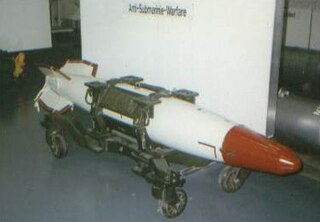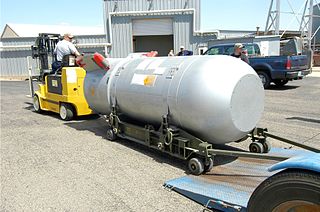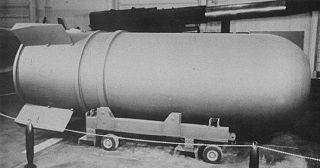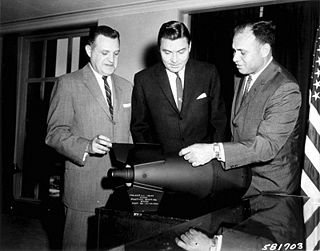Related Research Articles

The RUR-5 ASROC is an all-weather, all sea-conditions anti-submarine missile system. Developed by the United States Navy in the 1950s, it was deployed in the 1960s, updated in the 1990s, and eventually installed on over 200 USN surface ships, specifically cruisers, destroyers, and frigates. The ASROC has been deployed on scores of warships of many other navies, including Canada, Germany, Italy, Japan, the Republic of China, Greece, Pakistan and others.
A neutron bomb, officially defined as a type of enhanced radiation weapon (ERW), is a low-yield thermonuclear weapon designed to maximize lethal neutron radiation in the immediate vicinity of the blast while minimizing the physical power of the blast itself. The neutron release generated by a nuclear fusion reaction is intentionally allowed to escape the weapon, rather than being absorbed by its other components. The neutron burst, which is used as the primary destructive action of the warhead, is able to penetrate enemy armor more effectively than a conventional warhead, thus making it more lethal as a tactical weapon.

A nuclear bunker buster, also known as an earth-penetrating weapon (EPW), is the nuclear equivalent of the conventional bunker buster. The non-nuclear component of the weapon is designed to penetrate soil, rock, or concrete to deliver a nuclear warhead to an underground target. These weapons would be used to destroy hardened, underground military bunkers or other below-ground facilities. An underground explosion releases a larger fraction of its energy into the ground, compared to a surface burst or air burst explosion at or above the surface, and so can destroy an underground target using a lower explosive yield. This in turn could lead to a reduced amount of radioactive fallout. However, it is unlikely that the explosion would be completely contained underground. As a result, significant amounts of rock and soil would be rendered radioactive and lofted as dust or vapor into the atmosphere, generating significant fallout.

The WE.177, originally styled as WE 177, and sometimes simply as WE177, was a series of tactical and strategic nuclear weapons with which the Royal Navy (RN) and the Royal Air Force (RAF) were equipped. It was the primary air-dropped nuclear weapon in the United Kingdom from the late 1960s into the 1990s.

The B83 is a variable-yield thermonuclear gravity bomb developed by the United States in the late 1970s and entered service in 1983. With a maximum yield of 1.2 megatonnes of TNT (5.0 PJ), it has been the most powerful nuclear weapon in the United States nuclear arsenal since October 25, 2011. It was designed by Lawrence Livermore National Laboratory.

The B61 nuclear bomb is the primary thermonuclear gravity bomb in the United States Enduring Stockpile following the end of the Cold War. It is a low to intermediate-yield strategic and tactical nuclear weapon featuring a two-stage radiation implosion design.

The B57 nuclear bomb was a tactical nuclear weapon developed by the United States during the Cold War.

The Mk/B53 was a high-yield bunker buster thermonuclear weapon developed by the United States during the Cold War. Deployed on Strategic Air Command bombers, the B53, with a yield of 9 megatons, was the most powerful weapon in the U.S. nuclear arsenal after the last B41 nuclear bombs were retired in 1976.

The B28, originally Mark 28, was a thermonuclear bomb carried by U.S. tactical fighter bombers, attack aircraft and bomber aircraft. From 1962 to 1972 under the NATO nuclear weapons sharing program, American B28s also equipped six Europe-based Canadian CF-104 squadrons known as the RCAF Nuclear Strike Force. It was also supplied for delivery by UK-based Royal Air Force Valiant and Canberra aircraft assigned to NATO under the command of SACEUR. In addition, certain U.S. Navy carrier based attack aircraft such as the A3D Skywarrior, A4D Skyhawk, and A3J Vigilante were equipped to carry the B28.

The B-41 was a thermonuclear weapon deployed by the United States Strategic Air Command in the early 1960s. It was the most powerful nuclear bomb ever developed by the United States, with a maximum yield of 25 megatons of TNT. The B-41 was the only three-stage thermonuclear weapon fielded by the U.S.

In 1962, the U.S. Navy issued a requirement for a long-range high-precision air-to-surface missile. The missile, named the AGM-53A Condor, was to use a television guidance system with a data link to the launching aircraft similar to the system of the then projected AGM-62 Walleye.
Laydown delivery is a mode of delivery found in some nuclear gravity bombs: the bomb's descent to the target is slowed by parachute so that it lands on the ground without detonating. The bomb then detonates by timer some time later. Laydown delivery requires the weapon to be reinforced so that it can survive the force of impact.

The AGM-62 Walleye is a television-guided glide bomb which was produced by Martin Marietta and used by the United States Armed Forces from the 1960s-1990s. Most had a 250 lb (113 kg) high-explosive warhead; some had a nuclear warhead. The designation of the Walleye as an "air-to-ground missile" is a misnomer, as it is an unpowered bomb with guidance avionics, similar to the more modern GBU-15. The Walleye was superseded by the AGM-65 Maverick.

Nuclear weapons delivery is the technology and systems used to place a nuclear weapon at the position of detonation, on or near its target. Several methods have been developed to carry out this task.

A tactical nuclear weapon (TNW) or non-strategic nuclear weapon is a nuclear weapon which is designed to be used on a battlefield in military situations mostly with friendly forces in proximity and perhaps even on contested friendly territory. Generally smaller in explosive power, they are defined in contrast to strategic nuclear weapons, which are designed mostly to be targeted at the enemy interior away from the war front against military bases, cities, towns, arms industries, and other hardened or larger-area targets to damage the enemy's ability to wage war.
According to researcher Chuck Hansen, the W34 Python was a gas-boosted fission primary used in several designs of American thermonuclear weapons.
The B61 Family is a series of nuclear weapons based on the B61 nuclear bomb.

The Mark 101 Lulu was an airdropped nuclear depth charge developed by the United States Navy and the Atomic Energy Commission during the 1950s. It carried a W34 nuclear warhead, with an explosive yield of about 11 kilotons. It was deployed by the U.S. Navy for the purposes of antisubmarine warfare, in at least five different models, from 1958 through 1971. These nuclear weapons were also stockpiled overseas at the bases of NATO allies, under American military guard and control, for the potential use by maritime patrol planes of NATO. Thus was most notable at the air base of RAF St. Mawgan in Cornwall, for potential use by British Avro Shackleton patrol planes and the Royal Netherlands Navy's P-2 Neptune and P-3 Orion patrol planes. Neither the Lulu nor any other kind of nuclear antisubmarine or antiship weapon was ever used in combat by any country.

A nuclear depth bomb is the nuclear equivalent of the conventional depth charge, and can be used in anti-submarine warfare for attacking submerged submarines. The Royal Navy, Soviet Navy, and United States Navy had nuclear depth bombs in their arsenals at one point.

The UUM-44 SUBROC was a type of submarine-launched rocket deployed by the United States Navy as an anti-submarine weapon. It carried a 250 kiloton thermonuclear warhead configured as a nuclear depth bomb.
References
- ↑ "List of All U.S. Nuclear Weapons".
- ↑ The Nuclear Weapons of the United States Navy 1945 – 2013 by Don G. Boyer (Microsoft Word Document), March 2013 pp. 22-23.